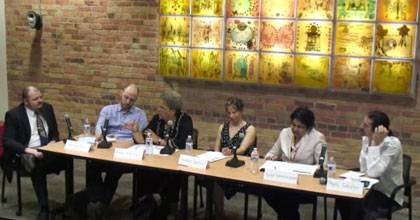
What's known: Governments and private donors pledged massive amounts of money to Haiti following the January 2010 earthquake that devastated parts of the island nation.
What's not known: What the heck happened to that money.
Read MoreThat was the crux of a conversation Thursday morning in Duke's Haiti Lab, the first of a series of conference sessions exploring the Haitian reconstruction effort following the massive earthquake.
The conference, "Humanitarianism in Haiti: Vision and Practice," brings together more than a dozen Haiti experts from government, journalism, public health, development and other fields. It continues Friday.
Thursday's first panel, which counted among its members former Haiti Prime Minister Michele Pierre-Louis, painted a sorry portrait of the ways aid money and other resources were distributed to the nation in the months and years following the earthquake.
Roughly $9 billion was pledged for short-term aid and long-term reconstruction, including $3 billion from the United States, said Vijaya Ramachandran, a senior fellow for the Center for Global Development, where she attempts to track aid money once governments and private donors disperse it.
Little money goes directly to Haiti's government. Rather, it is sent through the U.S. Agency for International Development, or USAID, to non-governmental organizations and for-profit redevelopment agencies to administer.
There, the money trail often goes cold, Ramachandran said, citing a lack of U.S. government transparency.
"We really don't know where this money has gone," Ramachandran said. "We have no data whatsoever."
A recent report from the Center for Economic and Policy Research appears to buttress the concerns voiced Thursday by Ramachandran and others. The report, released earlier this month, illustrates a lack of transparency on U.S. government spending on Haiti aid, noting in particular that there is little information available about money channeled by USAID award recipients to subcontracting agencies.
Pierre-Louis, who served as prime minister for about 14 months in 2008 and 2009, said the NGOs and private companies who receive most of the redevelopment funds shut Haitian officials out of the process and make decisions largely on their own.
"We have the feeling that the Haitian people are not part of the reconstruction process," she said, adding that Haitians are seen simply as "a reservoir of cheap labor."
Haiti experts had hoped otherwise, seeing the earthquake as an opportunity to truly change the country through an efficient, long-term reconstruction process that would involve Haitians themselves.
"There was a hope that the earthquake would be this transcendent moment that would shock people into action," said Jonathan Katz, a former Haiti-based Associated Press reporter and author of 'The Big Truck That Went By: How the World Came to Save Haiti and Left Behind a Disaster.' "That didn't really happen."
Instead, Haiti got some short-term relief in the form of food, re-built roads and hospitals and some new, if relatively temporary housing, said Joshua Nadel, an assistant professor of history at N.C. Central University and co-organizer of the conference.
But the long-term planning that will give Haiti the infrastructure required to maintain buildings, roads, schools, hospitals and the like hasn't yet emerged, said Nadel, who is spending a year at the Haiti Lab as a visiting faculty fellow within Duke's Humanities Writ Large initiative. And frustration is building as so little is known about where so much money has gone, he said.
"If you listen to the government, aid is being effectively spent and is improving peoples' lives and everything is rosey," he said. "But there are greater problems. If you look at Haiti, or Afghanistan, or any aid program in the world, you have the same problems. That's one thing we're trying to shine a light on."
The conference continues Friday at Duke's Smith Warehouse and is also being live-streamed here.
You can also follow the conference on Twitter using the hashtag #Haitiproject.